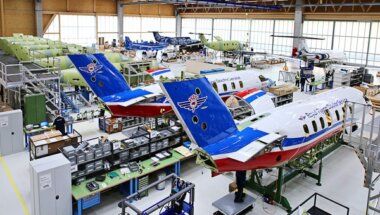Digitale Arbeitsabläufe, einschliesslich IoT-Geräte schützen und die Zusammenarbeit im globalen Betrieb vereinfachen.
Case Study Pilatus Aircraft Ltd.
Pilatus is a world-leading aircraft manufacturer. To connect its global operations and protect against cyber threats, the Swiss business has upgraded its entire network. The impact promises to accelerate the adoption of IoT use cases, transforming production times and bringing forward fresh innovation.
Demand for private aircraft lifts off
On the face of it, the global COVID-19 pandemic was anything but good for the aviation sector. Travel bans and grounded flights brought the industry to a standstill. But it has been a boon to one segment of the industry: private aircraft.
Sales of private aircraft are expected to reach $34.6 billion in 2023, their highest-ever level. There were 5.3 million private flights globally in 2022.
Growth is being driven by a number of factors: the convenience of direct flights, a rise in the shared ownership model, and the desire of the ultra-wealthy not to share cabins and airports with the mass market. The boom shows no signs of slowing. Globally, the number of people able to afford even part-ownership of a private jet continues to grow.
“We’ve seen substantial growth in each of the last three years and expect this to continue,” says Christoph Büeler, Pilatus Aircraft Ltd. “We’re calling this moment ‘Growth-Plus’.”

This is not to suggest that this is an easy opportunity. Aviation regulators want new aircraft to be less carbon emitting, customers are looking for flexibility to be able to operate from shorter runways, and the ultra-wealthy don’t want to wait long for their new planes to be delivered.
For Pilatus, the challenge is to cut production times, explore new materials, and find new areas of competitive advantage.
Using IoT to reveal production efficiencies
At the heart of the Pilatus growth strategy is a revamped network backbone, built on HPE Aruba Networking. The new network simplifies connections between global teams and allows the business to bring innovation to its production environment. In particular, using the HPE Aruba Networking wireless access points as gateways to the network accelerates the roll-out of IoT use cases. Already in use, temperature and motion sensors, connected to gateways in the HPE Aruba Networking access points, ensure that the materials move along the production line within a specific (and critical) temperature range.
“Through the use of IoT, we may find the next breakthrough in production efficiency or sustainability. HPE Aruba Networking Wi-Fi 6E access points will be key to new asset tracking use cases,” says Büeler. “It’s critical the network supports the transport of real-time data from these devices.”
“Pilatus customers value Swiss engineering and production,” Büeler adds. The hope is that more efficient production in Switzerland, with machines running at peak capacity and very little downtime, will shorten lead times for new planes. “The buyers of private aircraft might not only be driven by cost, but when they want something, they want it tomorrow,” he adds.
The vast majority of Pilatus operations remain in Switzerland, including all production, though the group is increasingly international looking. It has operations in Adelaide, Australia, and Denver, U.S., and may look to acquire new businesses as it continues to grow.

With the ability to remotely deploy network configurations to the wired and wireless network once physically installed (zero-touch provisioning), and to create network templates to fit defined connectivity and access conditions (automated role-based NAC), the HPE Aruba Networking architecture simplifies the task of spinning up new locations or absorbing acquisitions into the core business.
With HPE Aruba Networking, we go slice by slice for different use cases. When it comes to the security of the business, no one wants to be seen to have underinvested in the right technology.
In terms of the operational environment, the Open API-based integration of various operational technology (OT) management platforms with HPE Aruba Networking ClearPass continues to allow the secure onboarding of new and existing systems. Again, this accelerates the deployment and testing of new technologies while minimizing risk.
The unified network also strengthens links between teams on the ground in different parts of the world. Customer or operational feedback is easier to share with common collaboration tools in place. Insight gleaned from customers and colleagues will inevitably fuel product innovation, says Büeler. This innovation is likely to focus on lighter weights (extending the aircraft’s range) and the ability to have shorter take-off distances. The Pilatus PC-12 range already leads the industry in terms of short take-off distance.
“Our short take-offs are a unique selling point (USP),” says Büeler. “The use of composite materials, green fuels, or bespoke finishes for the customer will create new USPs.”
Through the use of IoT, we may find the next breakthrough in production efficiency or sustainability. It’s critical the network supports the transport of real-time data from these devices,
Christoph Büeler
Project Manager IT Operation, Pilatus Aircraft Ltd
Securely segmenting a diverse, global network
The HPE Aruba Networking core-to-edge architecture for Pilatus is built around HPE Aruba Networking CX family of data center and campus switch series and HPE Aruba Networking AP-510 series access points. These not only offer Wi-Fi 6 connectivity but also provide a seamless IoT gateway functionality to Pilatus. The entire security, including the onboarding of new devices and IoT technology, is managed and automated by HPE Aruba Networking ClearPass Policy Manager, while end-to-end visibility and control are achieved through HPE Aruba Networking AirWave. The same security policies and management templates can be applied throughout the network at the wired and wireless layers.
The unified approach, says Büeler, was driven by two factors: “Clearly, we see the benefits of global standards, but we were also concerned with cyber security threats. Malware and ransomware have the potential to be extremely disruptive. Senior management recognized the importance of investing in a network upgrade.”
The HPE Aruba Networking architecture, he continues, demonstrated the clearest means of securely segmenting and isolating different workloads. “Our previous network was very flat. Here, with HPE Aruba Networking, we define and control slice by slice for different use cases. When it comes to the security of the business, no one wants to be seen to have underinvested in the right technology.”
It is inevitable the network will become more critical to the business. There will be more devices to connect, more third parties to collaborate with, and more global teams to bring together. This presents an expanded number of entry points for cyber threats if not properly protected. Büeler says a coherent network security strategy, with one vendor, is sensible:
“From an IP security perspective, HPE Aruba Networking is the right decision.“

The network also delivers granular control and visibility. HPE Aruba Networking ClearPass provides transparency and a zero-trust approach to who or what is connected to the network, the use of HPE Aruba Networking AirWave enables Pilatus to operate the network at the most granular level. In the future, migrating the management to HPE Aruba Networking Central as a cloud-native platform will further extend the scalability and unification of global operations for Pilatus.
“We now have a homogenized network with clear connectivity management, less administration, and more automation,” says Büeler. “It has simplified what could have been a hugely complex operation.
HPE Aruba Networking partner SOFTEC supported Pilatus with valuable consulting, design and deployment services, and continues to deliver ongoing network support.
![]()
